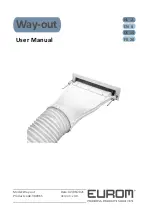
High-Pressure Switch (HPS) —
When the refriger-
ant high-side pressure reaches 426 psig (2937 kPa), the HPS
opens 24-v power to the compressor contactor and stops the
compressor. When the pressure drops to 320 psig (2206 kPa),
the switch resets and the compressor is allowed to restart.
Time Guard
T
II Device —
Time Guard II circuit pro-
vides for a delay of approximately 5 minutes before restart-
ing compressor after shutdown from safety device action.
On start-up, the Time Guard II timer causes a delay of
approximately 15 seconds after thermostat closes.
Refrigerant Service Ports —
Each unit system has
3 service ports: one on the suction line, one on the liquid
line, and one on the compressor discharge line. Be sure caps
on the ports are tight.
Cooling —
Set space thermostat to OFF position. Set
system selector switch at COOL position and fan switch at
AUTO. position. Adjust thermostat to a setting below room
temperature. Compressor starts on closure of contactor.
Check cooling effects at a setting below room tempera-
ture. Check unit charge. Refer to Refrigerant Charge
section on page 9.
Reset thermostat at a position above room temperature.
Compressor will shut off.
TO SHUT OFF UNIT — Set system selector switch at
OFF position. (Resetting thermostat at a position above room
temperature shuts unit off temporarily until space tempera-
ture exceeds thermostat setting.) Units are equipped with Cycle-
LOC™ protection device. Unit shuts down on any safety trip
and remains off. Check reason for safety trip.
Compressor restart is accomplished by manual reset of the
thermostat by turning the selector switch to OFF position
and then to ON position.
Sequence of Operation —
At start-up, the thermo-
stat calls for cooling. With all safety devices satisfied, the
compressor contactor and fan contactor energize, causing the
compressor and outdoor (condenser) fan motor to operate.
Contacts close, allowing the field-supplied and -installed in-
door (evaporator) fan contactor to function. The recom-
mended field-supplied and -installed liquid line solenoid valve
will also open, allowing the system to function in cooling.
As cooling demand is satisfied, the thermostat contacts break,
deenergizing the contactor causing the system to shut off.
The liquid line solenoid valve closes, minimizing the poten-
tial for refrigerant migration at this time. The compressor
does not restart until the thermostat again calls for cooling.
If a demand for cooling occurs within 5 minutes after the
thermostat is satisfied, the system will not restart due to the
feature of Time Guard II device. After the 5-minute time pe-
riod, the system will restart as normal on thermostat de-
mand. The system is protected by a Cycle-LOC device so
that the compressor will not start if a high-pressure or low-
pressure fault occurs. Compressor restart is accomplished by
manual reset of the thermostat by turning the selector switch
to OFF position and then to ON position. This should be
done only once. If system shuts down due to the same fault,
determine the problem before attempting to reset the Cycle-
LOC device.
Oil Charge (Tables 1A and 1B)
38AKS UNITS — Allow unit to run for about 20 minutes.
Stop unit and check compressor oil level. Add oil only if
necessary to bring oil into view in sight glass. Use only Carrier-
approved compressor oil.
Approved oils are:
Suniso 3GS
WF32-150
38AK UNITS — The 38AK units do not have a sight glass
and are factory charged with the correct amount of oil.
ALL UNITS — Do not reuse drained oil or use any oil that
has been exposed to atmosphere. Procedures for adding or
removing oil are given in Carrier Standard Service Tech-
niques Manual, Chapter 1, Refrigerants.
If oil is added, run unit for an additional 10 minutes. Stop
unit and check oil level. If level is still low, add oil only after
determining that piping system is designed for proper oil re-
turn and that system is not leaking oil.
Fig. 9A — Cooling Charging Chart — 38AK008,012
and 38AKS008,009,012 (60 Hz)
Fig. 9B — Cooling Charging Chart — 38AK008,012
and 38AKS008,009,012 (50 Hz)
10


































